We're surfin' all day and we're swingin' all night
When Brian Wilson died last week, a couple of film fans I know turned to Love & Mercy, the biopic about the legendary musician. But my brain went straight to Beach Party. Not because it’s a better film (I haven’t seen Love & Mercy) but because it’s a cousin of the early Beach Boys music of the same era: all sun, surf, and skin — basic teen desires wrapped up in the “California myth.” Beach Party isn’t quite a “teenage symphony to God” like Pet Sounds and “Good Vibrations,” but it is an act of worship in its own right. Like Wilson’s early career highlights, often co-written with Mike Love — e.g. “Surfin’ Safari,” “Little Deuce Coupe” — it’s upbeat, energetic, and even profound if you squint just right. There’s a reason both early Beach Boys and this film still hold cultural weight: They took a frivolous region- and era-specific scene and turned it into American legend.
If you’ve consumed any pop culture from the past 50 years, you’ve surely encountered a parody of Beach Party and its kin. Its most famous image is the artificial wave riding: footage of the shore spliced with actors fake-surfing in front of obvious rear projection. The style also inevitably includes tiki bar hangouts, bikinis, outdated hairstyles, and a lot of righteous, indecipherable slang. The colors are cranked up past nature’s limits, and the whole affair feels both groovy and a little deranged. The entire aesthetic became a shorthand for a certain kind of instantly-dated but endearing youth culture, ripe for spoof.
But here’s the twist: Beach Party was already kind of a parody. It knows how ridiculous it is. Perhaps the films most directly in its lineage these days are the Disney Channel Original Movie musicals. Of course, near-masterpiece Teen Beach Movie would use Beach Party as a starting point, but its voice most reminds me of Z-O-M-B-I-E-S, targeting a teen audience while nudging them in the ribs. The movie doesn’t just allow for the blurry edge between authentic and ironic representation, it thrives in it.

The film’s identity didn’t start that way. It was birthed by the low-budget production machine that was American International Pictures (AIP), a studio that operated with an explicit desire to both follow trends for a quick buck and try to manufacture new ones. AIP, helmed by the notoriously efficient and savvy duo James H. Nicholson and Samuel Z. Arkoff, specialized in quick, cheap genre films: juvenile delinquency dramas, drive-in horror, biker flicks, etc. Subtlety was not on the call sheet, but shamelessness was. And in allowing quirky talent to find a voice, it’s not a surprise that some films it made or distributed have gone down as cult classics: The Amityville Horror, The Masque of Red Death, Blacula, Brian De Palma’s Sisters, and many more. They sometimes bought the American distribution rights to low-budget films made internationally, like Mad Max.
In 1962, the two studio heads caught a forgettable Italian film about older men lusting after scantily clad beach girls. AIP didn’t buy the rights to the film, but they dug the setting. Nicholson and Arkoff had the genius idea to make their own teen-targeted film set on a Calfironia beach. (Although I’ve read multiple sources recounting this genesis, none actually state what that original Italian film was, just noting that it was minor and forgettable.) They sent word back to one of their regular screenwriters, Lou Rusoff. Rusoff turned in a standard juvenile delinquent script, but set on a shore. But when they reached out to William Asher, a veteran TV director with experience on I Love Lucy and The Twilight Zone, he only agreed to helm the film on the condition that he be allowed to rework the film into a musical comedy. Nicholson and Arkoff agreed, and Asher rewrote the script with Robert Dillon, a Roger Corman and AIP hand. That pivot was the spark. Out went the melodrama; in came a larger bikini wardrobe budget, an upbeat Les Baxter score, and lots of shenanigans.
(Asher and Dillon insisted Rusoff keep the film’s writing credit so he could use the wages to pay for his brain cancer treatment. Sadly, Rusoff passed away before Beach Party’s premiere.)
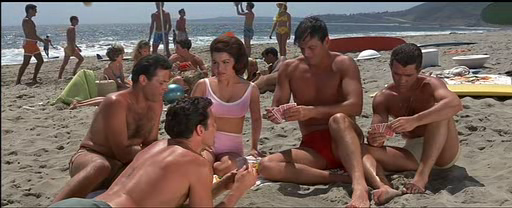
With the pivot to a lighter tone and an acclaimed sitcom director at the helm, AIP decided to broaden its potential audience by aiming the film at parents as well as the initially envisioned teens. That meant spending a little extra and bringing in more Hollywood gravitas than usual for the studio: B-lister Bob Cummings and Oscar-winner Dorothy Malone. For the younger set, AIP made a deal with Disney to loan out rising star Annette Funicello, under the strict condition that she remain chaste — no belly buttons allowed. After negotiations with Fabian Forte fell apart, AIP lucked into Frankie Avalon. Avalon had just enough babyfaced charisma to straddle the line between heartthrob and goofball. More importantly, he and Funicello had terrific onscreen chemistry — their old-married-couple bickering is believable and endearing.
The result is strange and delicious smoothie of tones and ideas: a beach movie, a teen rom-com, a musical, a satire, a B-movie cash grab, and a perfect time capsule of ‘60s surf culture. The overarching story is a simple arc of lovers quarreling then reuniting, and that simplicity is fine, as it lets the film breathe and try on different hats. Of all the film’s ambitions, the most frictionless and charming one is offering a hangout time capsule: The pseudo-documentary footage of ’60s beach life. Large chunks of the movie are dedicated to showing teens doing teen things on the shore: tanning, flirting, surfing, busting each other’s balls. These segments have an effortless sense of fun and even beauty, with gorgeous sunsets and beach horizons. Part of me always wishes Beach Party was a full-on, Linklater-style hangout movie from start to finish, conflict and narrative arcs be damned. Even with what we have, you can soak it all in, or you can apply a literary read on it: The beach is a threshold and transitional space just as adolescence is the shift from childhood into adulthood. In an ever-changing and scary adult world, the tide is reliable and steadfast. The foam rolling in and out, over and over, mirrors the push-pull of hormones and the rhythm of sex.
The action shifts at night to Big Daddy’s, a coffeehouse modeled after the real-life Laguna Beach spot Café Frankenstein, where late ‘50s beatniks and stoners once mingled and mutated into what we’d eventually call surfers. This set is a total standout — a multilevel loft with glowing signage, tiki ephemera, and an elevated stage that gives the performers unique space for performing. It’s here that Dick Dale and the Del Tones bring the house down, anchoring the movie in some authentic cool, even as everything around it gets cartoonier. Asher clearly tapped into an emerging culture, or, at a minimum, faked it into something believable and vibrant.
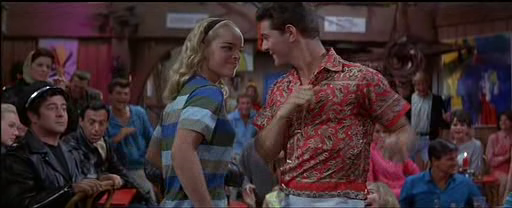
The film’s central scenario is a tiff between Frankie (Avalon) and Dolores (Funicello), which mostly serves as a delivery system for barely coded innuendo. Beach Party might be the horniest film ever made that’s still a soft PG. Nearly every line out of Frankie’s mouth is some variation of “when are we gonna do it already?” while Dolores fends him off with witty deflections. She invites all their friends to join them at the beach to avoid alone time with Frankie, fully aware of his intentions… and more-or-less explicitly admitting she reciprocates the desires but doesn’t feel ready to seal the deal. Frankie retaliates by flirting with Ava (Eva Six), the sultry Hungarian waitress from Big Daddy’s, and Dolores escalates the situation by throwing herself into the arms of the next warm body to pass — one who turns out to be an anthropologist.
That would be Professor Sutwell, played by Cummings with a mix of low-key detachment and double-take bafflement. He’s in town to study teen behavior as if it is an indigenous tribe — specifically their “primitive mating rituals” — which gives the film license to both ogle and deconstruct the teens’ sexual frustration and erratic behavior. (It also apparently gives the film license for lots of dated jokes about exotic cultures.) Sutwell is trailed by his pining assistant Marianne (Malone), who keeps waiting for him to notice she exists. Instead, he is drawn to Dolores as a subject for his “research,” treating her romantic overtures as enthusiastic academic assistance.
I really love Sutwell’s storyline, aided by Cummings’ clearly best-in-show performance. His plot offers sharp satire of the entire teen media industry, featuring adults chasing the meaning and weight of youth culture, trying to “figure out” the American adolescent when such a thing is diverse and ever-changing. Sutwell is essentially a stand-in for every adult trying to decode how teens click, particularly movie studios and cultural critics. This obsession with “cracking” teens inevitably results in a fetishization and vicarious participation in teen totems. By the end of the film, the same has happened to Sutwell, as he gradually transforms into a surfing teen himself. The satire stays light and avoids cynicism; the takeaway isn’t that the teens’ lifestyle and social dynamics are pointless trifle; rather, that they’re as ineffable and magical as they are silly and obtuse.
(Side note: Much derision and debate is devoted to the beard Cummings sports at the start of the film but trims later on. Beards being a symbol of old-fashioned stodginess is not something that holds true in the 2020s.)
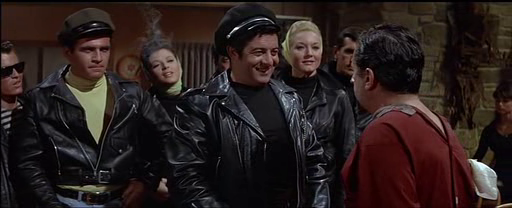
The film’s final plot thread, if you can even call it such, follows a biker gang called The Rats led by Eric Von Zipper (Harvey Lembeck). Von Zipper is the closest the movie gets to a traditional antagonist, but even that’s generous. Lembeck shows the movie leaning on its parody aspirations, as he’s a pretty direct riff on Marlon Brando’s character in The Wild One, but with negative danger and sex appeal, an inverse of ‘50s Brando. Von Zipper is a chubby, pint-sized, middle-aged blowhard who gets repeatedly outwitted by Professor Sutwell and falls victim to his paralyzing “nerve pinch.” The Rats are about as threatening as a group of boy scouts on scooters, and they have exaggerated speaking affectations. Their antics are the one portion of the film that is a bit too loud, chaotic, and sitcommy for my tastes. I do admire Lembeck’s commitment to the bit, though, and his willingness to flail and degrade himself in front of a camera. Von Zipper would become the franchise’s comic relief mascot.
In addition to everything else going on, Beach Party makes room for a handful of musical numbers. The songs are a blend of diegetic numbers performed at Big Daddy’s and non-diegetic numbers where characters, mostly Dolores, break out into song. The biggest highlight is Dick Dale and the Del Tones’ “Swingin’ and a-Surfin’,” a full on banger and prototypical slice of surf rock. The film opens with a sunny (if slight) duet between Avalon and Funicello that practically bursts with saccharine charm as they croon from a beach buggy. And even Annette’s solo, “Treat Him Nicely,” has a harmless earworm quality to it. Les Baxter’s score adds to the film’s inviting texture, giving the film a cinematic sweep despite its shagginess.
The performances ride the same tonal surfboard as the rest of the movie: straddling the entire spectrum between sincere and wacky. Avalon is not much of an actor, per se, but he carries his role with breezy self-assurance that’s just right. Funicello, meanwhile, plays Dolores with both warmth and restraint, never letting the character become either a full-on flirt or a total square (a balancing act Maia Mitchell couldn’t replicate in Teen Beach Movie). Cummings, as mentioned, gives the most layered performance, and frankly the funniest. His off-kilter quality brings Sutwell to life. Vincent Price makes a late cameo as Big Daddy, the oft-sleeping proprietor of the cafe. He name-drops his AIP film The Pit and the Pendulum. (”Bring me my pendulum, kiddies, I feel like swinging.”)
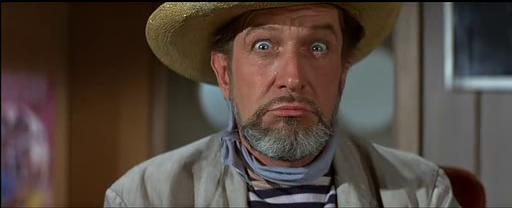
What makes Beach Party so culturally sticky, so recognizable 60+ years later, isn’t the music or the colors or the comic mayhem. It’s the way it weird, singular flavor of all those pieces coming together. Beach Party is its own mini universe you want to spend time in. It captures something real about being a teenager, too: the performative bravado, the omnipresent libido, the constant negotiation between vulnerability and tough swagger. And it does all this with visual zest. Its lack of edginess ultimately makes it timeless kitsch in the way that something like Gidget, which also captured a strand of teen beach culture the previous year with a more JD-adjacent plot, is not. I tend to believe that the best way to capture eternal truths about human nature is to, paradoxically, focus on very specific times and places, and Beach Party is no exception. As much as it’s a product of the pre-Summer of Love ‘60s in Orange County (or “The OC” as it would be called in another iconic teen beach property 40 years later) it’s also a manifesto of what makes teens tick, rendered in a pop art package.
At the same time, the movie is proudly a cheap cartoon, a throwaway piece of fluff. It embraces silliness whenever the mood strikes; approximately every 30 seconds or so. A pervasive, heightened comic mood, bordering on postmodern, pervades the film: Dolores sings a duet with her own reflection in the mirror (with some underwhelming effects). Candy Johnson wiggles uncontrollably whenever she’s on screen, her tassled dress performing a kind of hypnosis. A sidekick inexplicably has the name of Deadhead. A climactic fight at Big Daddy’s ends with pie-throwing and resolves via Sutwell’s kung fu paralysis, such that everyone is standing around, stock still, when it’s through. Locations occasionally bend logic with dubious continuity, turning into surreal, liminal spaces. The film has a dreamlike fluidity in how it treats setting and mood. One scene resembles a stage play; the next could pass for a half-remembered TV commercial; the next a gorgeous beach vista. To watch it is to ride the wave.
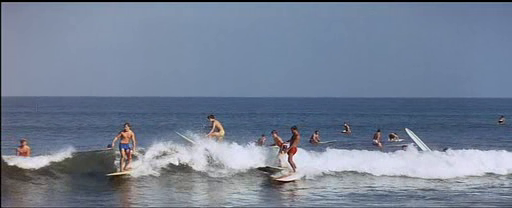
American International Pictures knew “hooting” when they saw it. Beach Party cost somewhere between $200,000 and $300,000 to make and pulled in $2.3 million — a monstrous return for a penny-pinching outfit. AIP didn’t hesitate: by the end of 1965, just two years later, they released a whopping nine sequels or spin-offs, most with the same cast and William Asher behind the camera. These follow-ups upped the zaniness and ditched whatever subtlety and introspection Beach Party boasted: though the teens showed up to the box office, the grown-ups mostly stayed home, so the more ambitious, cerebral bent of Sutwell’s subplot disappeared from later entries. The most famous follow-up (and the best) is the fifth entry, Beach Blanket Bingo, which probably surpasses the original in name recognition at this point. But none of its sequels — at least, of the five I’ve seen — have quite the same sharpness and color and wit of the original Beach Party.
Is It Good?
Very Good (6/8)
Below is a podcast episode I recorded with Brian a few years ago when I was slightly more ambivalent on the film
Dan is the founder and head critic of The Goods. Follow Dan on Letterboxd. Join the Discord for updates and discussion.

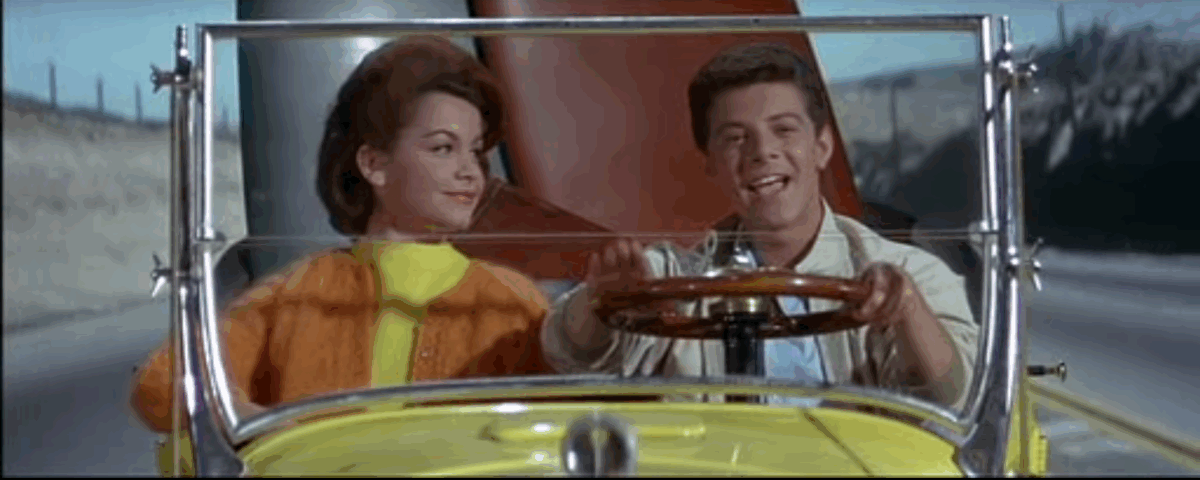
5 replies on “Beach Party (1963)”
Didn’t make it into the review, but… unlike all of its sequels (except Ski Party) Beach Party has only had a cheap DVD release and no Blu-ray release. It was excluded in Shout’s AIP beach box set for reasons I cannot find documented anywhere. This is near the top of my wishlist of films to get an HD release. (All of the streaming I found appears to be the same low-res transfer as the DVD.)
Checked it out, as I’d been meaning to for ages (I’ve owned the cheap DVD set–double sided? are you for real?–for a few years; I knew it didn’t have the Dr. Goldfoots, but I’m bummed to learn it skimps on Pajama Party because I guess Avalon wasn’t in it, or Sergeant Deadhead–good grief, they made a lot of these). Had a swell time, enjoyed it a lot; good review, too, the notion that Sutwell is a metacinematic device of sorts is pretty insightful.
Eleven sequels and spinoffs within 4 years. Asher himself directed and co-wrote 5 sequels that released in 1964 and 1965. Just to keep himself busy, he also directed Johnny Cool between Beach Party and its first sequel Muscle Beach Party. Truly the faddiest of fads.
I’m not sure I’d pay for a boutique release of the set, because it’d be like $200 knowing Criterion and the like, but maybe just this one.
I admit that the only ‘California Sound’ I’m very familiar with is HOTEL CALIFORNIA (Eagles man, now and forever – yet another reason to love Linda Ronstadt).
Still, this sounds like Fun (Capital much-deserved): any film where VINCENT PRICE rocks up as a hipcat beachfront property owner called “Big Daddy” has at least one claim to immortal fame and our heartfelt gratitude.
Price’s cameo is very small, but of course he leaves an impression, and it plays well in re-watch knowing the sleeping owner is actually Vincent Price (or more likely an extra swapped in for Price for most scenes, but the point stands).